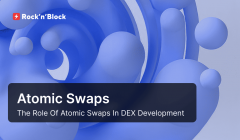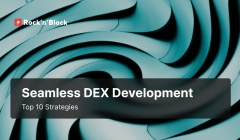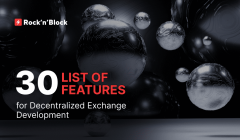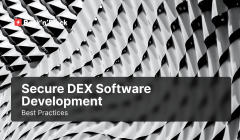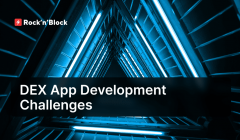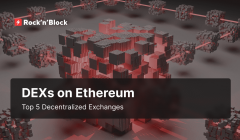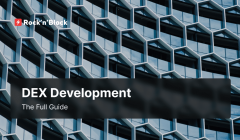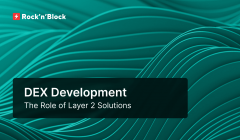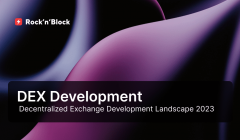Create a Decentralized Exchange Like dYdX: Ultimate Guide
03 May 2024Unlocking the potential of decentralized finance (DeFi) hinges on the development of innovative decentralized exchanges, and dYdX stands as a beacon of inspiration in this realm. With its groundbreaking features and open-source nature, dYdX has revolutionized the landscape of decentralized trading. For entrepreneurs and developers who want to create a decentralized exchange like dYdX, we explore the key steps and considerations involved in creating a decentralized exchange akin to dYdX, offering insights and guidance to embark on this transformative journey.

Understanding dYdX: A Brief Overview
Since its inception in 2017 by Antonio Juliano, dYdX has been a decentralized exchange that offers a multifaceted DeFi platform. Initially known for its margin trading capabilities, dYdX has expanded to offer a wider range of financial products, including perpetual contracts. One of its defining characteristics is its open-source codebase, which empowers developers worldwide to explore, experiment, and even create a decentralized exchange like dYdX. This accessibility to the underlying codebase not only fosters transparency but also democratizes the process, allowing anyone with the requisite skills to leverage and adapt dYdX's functionalities for their own DeFi endeavors.
As of March 25, 2024, DefiLama data shows a dYdX’s Total Value Locked of $513.67 million, highlighting the significant capital flowing into decentralized finance ecosystems. dYdX's market capitalization is currently $1.586 billion, reflecting strong investor confidence in the platform. Looking ahead, the token price prediction for 2024 suggests a bullish trajectory, with expectations of a maximum price surge to $26.55 by December 2024.
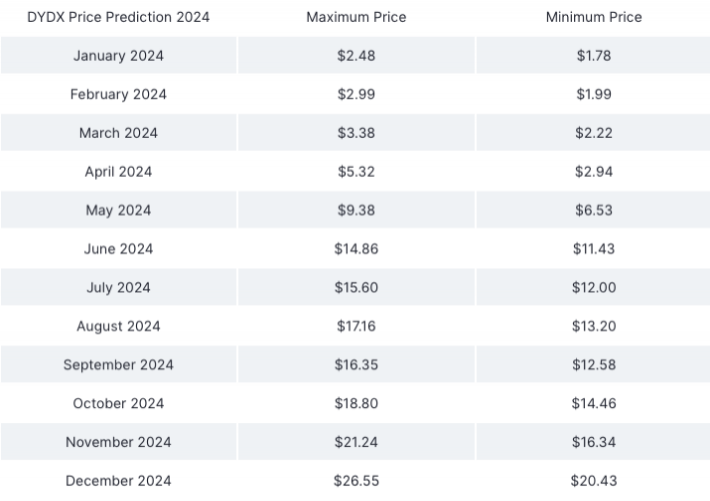
DYDX Price Prediction 2024 (in USD) – CoinMarketCap
The forecast predicts a 20-fold increase from the minimum price, indicating potential for substantial gains. Despite occasional dips, the overall trend for dYdX appears positive throughout the year, reinforcing market optimism. Looking ahead, price projections from 2024 to 2030 anticipate significant growth, with the maximum price forecasted to reach $367.053 by 2030. These statistics offer valuable insights for entrepreneurs and developers who want to create a decentralized exchange like dYdX, however, it is important to recognize the unpredictable nature of the cryptocurrency market and manage risks when making investment decisions.
Perpetual DEX: Redefining Trading Dynamics
dYdX's core concept is perpetual contracts, a derivative instrument designed to replicate the behavior of traditional futures contracts while eliminating the limitations caused by expiration dates. Perpetual contracts allow traders to hold positions indefinitely, unlike traditional futures which have a predetermined settlement date.
Key Features of Perpetual DEX
1. Continuous Trading Opportunities: Perpetual decentralized exchange development like dYdX enable traders to engage in non-stop trading activities, allowing them to initiate, modify, or close positions at any time without the limitations imposed by contract expirations.
2. Funding Mechanism: Perpetual contracts use a unique funding mechanism to ensure that the contract price closely follows the spot price of the underlying asset. This mechanism involves periodic payments between long and short positions to maintain the market balance.
3. Leverage Trading: Using the power of perpetual contracts, traders can increase their market exposure by margin trading, thereby increasing potential profits while also increasing the risk of loss. dYdX facilitates margin trading with adjustable leverage levels to suit different risk preferences.
4. Access to Leverage and Derivatives Trading: Creating a decentralized exchange like dYdX provides users with access to derivative trading through perpetual contracts, allowing them to speculate on the price movements of various crypto assets without owning them outright. This feature expands the range of trading opportunities available on the platform.
5. Liquidation Mechanism: To mitigate the risks associated with leveraged trading, perpetual DEX development employs sophisticated liquidation mechanisms designed to automatically close out positions when they approach certain predetermined thresholds, safeguarding the integrity of the market.
6. Risk Management Tools: In perpetual DEX development, risk management tools like stop-loss orders and position size limits are vital. Stop-loss orders enable users to automatically sell their assets at a predetermined price, protecting them from significant downturns in market conditions. Position size limits restrict the maximum exposure users can have to a particular asset, preventing over-leveraging and excessive risk-taking.
Learn more about perpetual DEXs: DEXvolution. Unleashing the Potential of Perpetual DEX
Key Features of dYdX v4
If you plan to create a decentralized exchange like dYdX, it's imperative that you stay abreast of the protocol's latest features, such as its newest version – v4. The dYdX v4 system architecture represents a significant evolution from previous iterations, transitioning towards a fully decentralized and standalone L1 blockchain solution. Unlike its predecessors, such as v3, which relied on smart contracts deployed to existing chains supplemented by centralized cloud services, v4 will operate as a standalone L1 blockchain. This new iteration, known as the dYdX Chain, will feature a decentralized off-chain order book and matching engine. Leveraging the Cosmos SDK and CometBFT PoS consensus protocol, the dYdX Chain aims to achieve greater decentralization and autonomy, reducing reliance on external infrastructures. As the release of v4's mainnet open-source software approaches, the dYdX team offers an overview of their innovative creation.
Enhanced Transaction Capacity
The dYdX v4 Chain boasts an impressive throughput capability, supporting up to 2,000 transactions (or trades) per second. This notable achievement surpasses the transaction speeds observed on many other Layer 1 blockchain networks. Such heightened throughput capacity is pivotal in delivering an optimized trading experience, particularly as DeFi protocols endeavor to rival centralized exchanges.
Comprehensive Protocol Control
With the migration to dYdX v4, the platform affords full-stack control, empowering the dYdX community to fine-tune the protocol according to their precise requirements. This level of control facilitates the implementation of tailored features and adjustments aimed at optimizing the platform's performance. For instance, it enables direct measures to counter issues associated with Maximal Extractable Value (MEV) while customizing critical properties to uphold competitiveness and responsiveness to the ever-evolving demands of users.
Protocol (or “Application”)
dYdX v4 introduces a cutting-edge protocol built on top of CometBET and utilizing CosmosSDK, offering a robust and efficient solution for decentralized trading. The protocol, operating as an L1 blockchain, leverages a proof-of-stake consensus mechanism, characteristic of CosmosSDK blockchains. The node software, written in Go and compiled into a single binary, powers the network, comprising two distinct types of nodes: Validators and Full Nodes.
-
Validators: play a pivotal role in maintaining the integrity of the network by storing orders in an in-memory orderbook, gossipping transactions, and producing new blocks through a consensus process.
-
Full Nodes: while not participating in consensus, facilitate network connectivity, process new committed blocks, and maintain a comprehensive view of the dYdX Chain and its history.
Indexer
In dYdX v4, the Indexer plays a pivotal role in efficiently serving blockchain data to end-users in a user-friendly manner. By consuming real-time data from a v4 full node and storing it in databases, the Indexer facilitates quick access to this data through websockets and REST requests. This ensures that users can access blockchain data without overloading validators, enhancing the overall usability and accessibility of the dYdX platform.
Front-Ends
dYdX is crafting three open-source front-ends to ensure a seamless decentralized experience: a web app, an iOS app, and an Android app. The web app, developed with Javascript and React, interacts with the Indexer via an API for off-chain orderbook data and executes trades directly on the chain. Its codebase and deployment scripts will be open-sourced for easy deployment on any domain via IPFS/Cloudflare gateway. Likewise, the iOS and Android apps, built in native Swift and Kotlin, will also interact with the Indexer and execute on-chain trades. These mobile apps will be open-sourced, facilitating deployment to the App Store or Play Store, albeit App Store deployment necessitates a developer account and Bitrise account for submission.
Lyfecycle of an Order
In the lifecycle of an order on dYdX v4, the process unfolds as follows:
1. User Placement: A user initiates a trade either through a decentralized front-end or via API.
2. Routing to Validator: The order is routed to a validator, which broadcasts the transaction to other validators and full nodes to update their orderbooks.
3. Consensus Proposer: Through the consensus process, one validator is designated as the proposer. This validator matches the order and includes it in the next proposed block.
4. Consensus Approval: If at least 2/3 of validator nodes vote to confirm the block, it is committed and stored on-chain by all validators and full nodes. Otherwise, the block is rejected.
5. Data Streaming: Upon block commitment, updated on-chain and off-chain data is streamed from full nodes to Indexers. The Indexer then provides this data via API and Websockets to the front-end and external services querying for it.
Rewards Mechanism
With the introduction of full trading, the dYdX Chain now offers three distinct reward mechanisms: Staking Rewards, Trading Rewards, and a 6-month Launch Incentive Program. Staking Rewards primarily consist of USDC and can be claimed manually by Stakers on a per-block basis. Trading Rewards, on the other hand, are rewarded in dYdX and are automatically distributed to eligible dYdX Chain addresses on a per-block basis. Traders do not need to wait or manually claim their dYdX-denominated Trading Rewards, simplifying the process. Currently, traders on the dYdX Chain have the opportunity to earn up to 50,000 DYDX per day in Trading Rewards. This comprehensive reward system incentivizes both staking and trading activities, contributing to the vibrant ecosystem of the dYdX platform.
If you want to create a decentralized exchange like dYdX, it's crucial to be informed about these features to ensure your platform remains competitive and relevant. By proactively considering these features, you can position your DEX for success and contribute to the continued innovation and decentralization of the DeFi space.
How to Create a Decentralized Exchange like dYdX
Creating a decentralized exchange like dYdX involves several intricate steps, each crucial for the successful development and deployment of the platform. Here's a comprehensive guide to help you navigate through the DEX development process:
Step 1. Define Objectives and Requirements
Before diving into development, clearly outline your goals and the specific features you aim to incorporate into your DEX. Consider the functionalities offered by dYdX and determine which ones you want to integrate into your platform. Ensure that your objectives align with the general goal to create a decentralized exchange like dYdX.
Step 2. Choose the Right Blockchain Platform
Choose the right blockchain platform for your DEX development. Ethereum is a popular choice due to its robust smart contract capabilities and extensive developer community. However, dYdX recently announced its own Cosmos-based blockchain – dYdX Chain. The new chain aims to provide transparent and secure trading of derivatives, operated entirely by code and governed by its user community. Other options include BNB Chain, Solana, and Polkadot. Evaluate each platform's scalability, security, and ecosystem support to make an informed decision.
Step 3. Fork dYdX Codebase
The next step on the way to create a decentralized exchange like dYdX is forking the dYdX codebase from its repository on GitHub or other relevant platforms. This provides you with a foundational framework to build upon and customize according to your requirements.
Step 4. Customize and Modify
Tailor the dYdX codebase to suit your specific needs and preferences. Customize the user interface, backend functionalities, and smart contract logic to reflect the branding and feature set of your DEX. Modify existing components or add new features as necessary to differentiate your platform from dYdX and meet the demands of your target audience.
Step 5. Smart Contract Development
Smart contract development is a key step to implement the core functionalities of your DEX, such as trading, order matching, and asset management. Use Solidity or other smart contract languages compatible with your chosen blockchain platform. Implement features like margin trading and perpetual contracts, keeping in mind the complexity and security implications of each feature.
Step 6. User Interface Design
Design an intuitive and user-friendly interface for your DEX to enhance user experience. Create visually appealing layouts and interactive components that facilitate seamless navigation and trading. Ensure that your UI design caters to both novice and experienced traders, reflecting the accessibility and sophistication of dYdX.
Step 7. Test Your Forked DEX
Testing is a crucial aspect in the process of creating a decentralized exchange like dYdX. Thoroughly test your DEX across various scenarios to identify and rectify any bugs or issues. Conduct security audits, unit tests, integration tests, and end-to-end tests to validate the functionality and reliability of your platform.
Step 8. Deployment
After successfully completing all checks, deploying the forked dYdX DEX to the mainnet marks the beginning of live trading activities. This is a significant achievement in the journey to create a decentralized exchange like dYdX tailored to unique specifications and preferences.
Step 9. Maintenance and Updates
Continuously monitor and maintain your DEX to ensure optimal performance and security. Regularly update your smart contracts and infrastructure to incorporate new features, address vulnerabilities, and adapt to evolving market dynamics. Stay engaged with the community and solicit feedback to drive ongoing improvements and enhancements.
By following these steps diligently, including forking the dYdX codebase and customizing it to your specifications, you can create a decentralized exchange that offers innovative features and empowers users to trade and invest in crypto assets with confidence and convenience.
Explore more forking opportunities with our related guides:
Create a DEX like Uniswap: Overview and Forking Guidelines
Create a DEX like PancakeSwap: A Step-by-Step Guide
Conclusion
Venturing into the creation of a decentralized exchange like dYdX is not merely about replicating existing features, but about embracing innovation and pushing the boundaries of decentralized finance. By harnessing the power of open-source technology and understanding the evolving needs of users, aspiring entrepreneurs and developers can embark on a journey to create a perpetual DEX that not only rivals centralized exchanges but also fosters greater financial inclusion and empowerment. While the road ahead may be challenging, the potential rewards are boundless. As the DeFi landscape continues to evolve, decentralized exchanges like dYdX play a pivotal role in shaping the future of finance.
Developing a decentralized exchange like dYdX involves dealing with technical complexities such as smart contract implementation, network architecture design, blockchain technology, consensus mechanisms, and security protocols. Partnering with blockchain development experts like
Rock'n'Blockprovides access to technical expertise and industry insights. Rock'n'Block can provide guidance and support throughout the development process, from addressing scalability issues to ensuring robust security measures. With our assistance, you can overcome technical hurdles and create a decentralized exchange that sets new standards in the world of decentralized finance.
Disclaimer: This article is intended solely for informational purposes and does not constitute financial advice or promotion. Readers are encouraged to do their own research (DYOR) and exercise caution before making any cryptocurrency-related decisions.
We ❤️ Development
Follow us on social media to receive the hottest blockchain development updates
Twitter ⚡️Telegram⚡️LinkedIn⚡️Facebook
